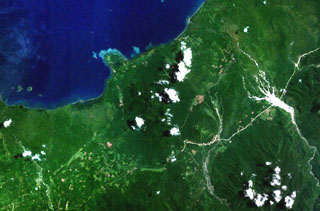Report on Sulu Range (Papua New Guinea) — 12 July-18 July 2006
Smithsonian Institution / US Geological Survey
Weekly Volcanic Activity Report, 12 July-18 July 2006
Managing Editor: Sally Sennert.
Please cite this report as:
Global Volcanism Program, 2006. Report on Sulu Range (Papua New Guinea) (Sennert, S, ed.). Weekly Volcanic Activity Report, 12 July-18 July 2006. Smithsonian Institution and US Geological Survey.
Sulu Range
Papua New Guinea
5.5°S, 150.942°E; summit elev. 610 m
All times are local (unless otherwise noted)
The RVO reported that seismic activity from the Sulu Range continued at a high level during 13-15 July. No emissions were reported during this period. According to news reports, on 16 July disaster officials in Papua New Guinea evacuated three villages and moved 1,400 people to camps outside of the hazard zone.
Geological Summary. The Sulu Range consists of a cluster of partially overlapping small stratovolcanoes and lava domes in north-central New Britain off Bangula Bay. The 610-m Mount Malopu at the southern end forms the high point of the basaltic-to-rhyolitic complex. Kaiamu maar forms a peninsula with a small lake extending about 1 km into Bangula Bay at the NW side of the Sulu Range. The Walo hydrothermal area, consisting of solfataras and mud pots, lies on the coastal plain west of the SW base of the Sulu Range. No historical eruptions are known from the Sulu Range, although some of the cones display a relatively undissected morphology. A vigorous new fumarolic vent opened in 2006, preceded by vegetation die-off, seismicity, and dust-producing landslides.
Sources: Rabaul Volcano Observatory (RVO), Association of American Publishers

